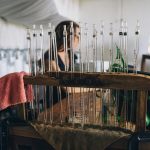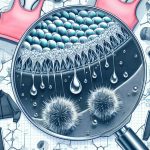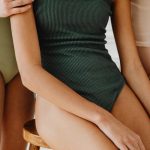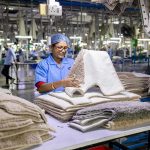When choosing activewear, you might wonder what really sets moisture-wicking fabrics apart from regular ones. Understanding terms like absorption versus wicking can change how you pick your gear. You’ll also want to know how fabrics pull sweat away and dry quickly to keep you comfortable. Before you decide, it’s important to grasp these concepts—they’re the foundation of performance clothing, and they might surprise you in how much they affect your experience.
Table of Contents
Key Takeaways
- Moisture-wicking fabrics pull sweat away from the skin through capillary action, keeping wearers dry and comfortable during physical activity.
- Synthetic fibers like polyester and nylon are hydrophobic, enhancing moisture-wicking and quick-drying properties compared to cotton.
- Effective moisture management reduces chafing and improves evaporation by spreading sweat across fabric surfaces for faster drying.
- Innovative moisture-wicking technologies include smart textiles and breathable designs that adapt to body temperature and environmental conditions.
- Proper care, such as avoiding fabric softeners and following washing instructions, maintains the moisture-wicking performance and durability of garments.
Absorption vs. Wicking
Although absorption and wicking both deal with moisture, they work very differently.
When you look at absorption methods, they involve materials soaking up liquid directly, holding it within the fibers. This means the fabric becomes wet and heavy.
On the other hand, wicking materials don’t trap moisture; instead, they pull sweat away from your skin and spread it across the fabric’s surface. This process helps the moisture evaporate faster, keeping you dry.
Understanding this difference is essential because absorption methods can leave you feeling damp, while wicking materials are designed to manage moisture more efficiently.
Benefits of Moisture-Wicking Fabrics
When you wear moisture-wicking fabrics, you stay drier and more comfortable during physical activities because these materials pull sweat away from your skin and speed up evaporation.
Moisture-wicking fabrics keep you dry and comfortable by pulling sweat away and speeding evaporation during workouts.
This sweat management improves temperature regulation and reduces moisture retention, enhancing your comfort and skin health.
You’ll notice better athletic performance thanks to less distraction from damp clothing and odor control that keeps you fresh.
Plus, these fabrics offer durability and fashion appeal, perfect for your active lifestyle.
Benefits include:
- Comfort enhancement through effective moisture control
- Support for athletic performance by maintaining ideal body temperature
- Long-lasting fabric durability combined with odor control
Choosing moisture-wicking fabrics means you’re set for comfort, performance, and style all day long.
Capillary Action Explained
You’ll notice moisture moves through fabric thanks to capillary action, which pulls liquid along tiny fibers.
This natural process helps wick sweat away from your skin, keeping you dry and comfortable.
Understanding how capillary action works lets you appreciate why certain fabrics perform better in moisture transport.
How Capillary Action Works
Since moisture moves through fabrics in surprising ways, understanding how capillary action works can help you choose the right materials.
Capillary action relies on capillary dynamics, where liquid movement occurs within tiny spaces between fibers without external forces. This natural process pulls moisture away from your skin, keeping you dry and comfortable.
Here’s how capillary action works in fabrics:
- Liquid moves through narrow channels created by closely packed fibers.
- Adhesion between the liquid and fiber surfaces drives the upward movement.
- Surface tension helps maintain the flow against gravity.
Role in Moisture Transport
Although capillary action might seem like a simple process, it plays an essential role in how moisture moves through fabrics to keep you dry.
When sweat forms, capillary action drives the moisture distribution by pulling liquid away from your skin and into the tiny fibers of the fabric. This natural transport mechanism works against gravity, guiding moisture through narrow channels within the material.
Because of this, moisture doesn’t just sit on your skin or the fabric’s surface; it spreads evenly across the fabric’s inner structure.
Understanding this helps you pick clothing with effective moisture-wicking properties, as capillary action is a critical transport mechanism enabling quick drying and improved comfort during physical activities.
Drying Mechanisms in Fabrics
Three main drying mechanisms work together to remove moisture from fabrics: evaporation, absorption, and wicking. Understanding these helps you choose the right material based on drying rates and performance in your fabrics comparison.
Evaporation, absorption, and wicking combine to efficiently remove moisture from fabrics.
- Absorption: Some fabrics soak up moisture quickly but hold onto it longer, slowing drying.
- Wicking: This pulls moisture away from your skin to the fabric’s surface, speeding up drying.
- Evaporation: Moisture turns into vapor and escapes, completing the drying process.
When you compare fabrics, focus on how quickly they wick moisture and how fast they dry. For example, synthetic fibers usually have better wicking and faster drying rates than cotton.
Knowing these mechanisms lets you pick fabrics that keep you dry and comfortable during any activity.
Evaporation and Its Role
How does evaporation help keep you dry when moisture moves through fabric? The evaporation process plays a vital role by turning liquid sweat into vapor, allowing moisture to leave your clothing and skin.
When fabric pulls sweat away from your body, it spreads it over a larger surface area, increasing the evaporation rates. Faster evaporation means your clothes dry quickly and you feel more comfortable.
Factors like temperature, humidity, and airflow affect these rates, so fabrics designed to optimize evaporation keep you dry even during intense activity.
Fabric Construction Techniques
You’ll notice that yarn cross-section design plays a big role in how fabric handles moisture.
Techniques that create micropores in the material help air flow and speed up drying.
Let’s explore how these construction methods boost moisture-wicking performance.
Yarn Cross-Section Design
Although it might seem subtle, the shape of a yarn’s cross-section plays an essential role in moisture-wicking performance. Different yarn types use unique cross-sectional designs to enhance moisture control and overall comfort.
By choosing the right cross section, manufacturers achieve significant performance enhancement in activewear and technical fabrics.
Here’s what makes yarn cross-section design important:
- Increased surface area: Shapes like trilobal or hollow fibers boost moisture transport.
- Capillary action: Specific designs channel sweat away from your skin quickly.
- Airflow improvement: Unique cross sections improve breathability and drying speed.
Understanding these cross section benefits helps you pick fabrics that keep you dry and comfortable during workouts or daily wear.
Micropore Formation Methods
Micropores in fabric play an essential role in enhancing moisture-wicking by allowing air and sweat to pass through efficiently. You’ll find several micropore techniques, such as mechanical perforation, laser etching, and chemical etching, each with distinct applications. These methods create tiny holes that improve breathability and quick-drying properties but come with pros and cons you should consider.
| Technique | Advantages | Disadvantages |
|---|---|---|
| Mechanical | Cost-effective, durable | Limited precision |
| Laser Etching | High precision, customizable | Higher cost, slower process |
| Chemical Etching | Uniform pores, scalable | Environmental concerns |
Understanding these micropore applications helps you choose the right fabric construction for ideal moisture-wicking performance.
Fiber Types Used in Moisture-Wicking
Different fibers play an essential role in how effectively a fabric wicks moisture away from your skin. Understanding the fiber types helps you choose the right garment for moisture control and comfort factors.
You’ll find both natural fibers and synthetic fibers used in performance fabrics, often combined in fiber blends to enhance durability aspects and wicking technologies.
Textile innovations focus on improving moisture transport while maintaining eco friendly materials. Here’s what to evaluate:
- Natural fibers like cotton offer breathability but may lack quick-drying properties.
- Synthetic fibers such as polyester excel in moisture-wicking and durability.
- Fiber blends combine the best of both, balancing comfort and performance.
Hydrophobic Fibers Defined
You’ll find hydrophobic fibers repel water instead of absorbing it, which helps keep you dry.
These fibers play a key role in moisture-wicking by pushing sweat away from your skin.
Understanding their traits can help you choose the right gear for staying comfortable.
Water-Repelling Fiber Traits
Although hydrophobic fibers might seem similar to other materials at first glance, they actively repel water instead of absorbing it. This water-repelling trait comes from advanced water repellent technology and specific fiber surface treatments that create a barrier on the fiber.
When you choose fabrics with these fibers, you benefit from:
- Reduced moisture retention, keeping you dry and comfortable
- Enhanced durability against water exposure and stains
- Faster drying times compared to hydrophilic fibers
These traits make hydrophobic fibers ideal for outdoor gear and activewear, where water resistance and quick drying are essential.
Understanding how fiber surface treatments modify the fiber’s interaction with water helps you pick the right fabric for your needs, especially when moisture management is a priority.
Role in Moisture-Wicking
When hydrophobic fibers come into play, they don’t absorb moisture but instead push it away, helping your skin stay dry. These fibers are essential for effective moisture management, ensuring sweat moves from your skin to the fabric surface where it can evaporate quickly. This enhances fabric performance, keeping you comfortable during intense activity.
Here’s how hydrophobic fibers contribute:
| Fiber Type | Moisture Behavior | Impact on Fabric Performance |
|---|---|---|
| Polyester | Repels water, dries fast | Maintains dryness, lightweight |
| Nylon | Resists moisture absorption | Durable, quick drying |
| Olefin (Polypropylene) | Does not absorb water | Excellent wicking, breathable |
| Acrylic | Hydrophobic, sheds moisture | Keeps warmth, moisture-free |
Understanding these fiber traits helps you choose the best moisture-wicking gear.
Hydrophilic Fibers Defined
Hydrophilic fibers attract and absorb moisture, drawing sweat away from your skin to keep you dry and comfortable. These fibers possess unique hydrophilic characteristics that make them ideal for moisture management.
When you wear garments made from hydrophilic fibers, you benefit from their ability to quickly soak up sweat and spread it across the fabric surface, speeding up evaporation.
Here’s what makes hydrophilic fibers stand out:
- Efficient moisture absorption and transfer
- Enhanced breathability through moisture dispersion
- Common use in sportswear, activewear, and casual clothing
Understanding hydrophilic applications helps you choose fabrics that improve comfort during physical activity or daily wear.
These fibers work by embracing moisture rather than repelling it, making them a key part of moisture-wicking technology.
Innovative Moisture-Wicking Materials
Moisture management doesn’t stop at hydrophilic fibers; advances in textile technology have brought innovative materials that take moisture-wicking to the next level.
When you explore smart textiles, you’ll find fabrics with sensors that respond to sweat, adjusting breathability and drying speed in real time. Breathable designs guarantee air flows freely, boosting comfort during intense activity.
Eco friendly options now combine performance enhancements with fabric sustainability, reducing environmental impact without compromising function. You’ll notice durability factors built into these materials, so they withstand repeated wear and washing.
Sustainable fabrics now deliver high performance and durability, minimizing environmental impact while lasting through repeated use.
Climate adaptability is another focus—these textile innovations help regulate body temperature whether you’re in cold or hot environments.
Jersey Knit and Moisture Transport
When you wear jersey knit fabric, its unique structure helps move moisture away from your skin.
You’ll notice how the loops and stitches create channels that transport sweat efficiently.
Understanding this mechanism shows why jersey is great for staying dry during activity.
Jersey Fabric Structure
A jersey knit fabric stands out for its unique structure that helps manage sweat and keeps you comfortable. This fabric’s interlocking loops create a smooth surface that’s soft against your skin while promoting airflow.
Different jersey fabric types, like single-knit and double-knit, offer varied stretch and durability, making them versatile for your activewear or casual clothing.
When choosing jersey fabric, consider these key aspects:
- Breathability: Loops allow moisture to evaporate quickly.
- Stretch: Fabric moves with your body for comfort.
- Applications: Ideal for sportswear, t-shirts, and loungewear.
Understanding jersey fabric structure helps you select the right material that balances moisture management with comfort for your specific needs.
Moisture Movement Mechanism
Although jersey knit fabrics feel soft and flexible, they work hard to move sweat away from your skin efficiently.
Their unique knit structure enhances moisture dynamics by creating tiny channels that facilitate liquid transport. When you sweat, moisture quickly spreads across the fabric surface instead of pooling, allowing it to evaporate faster.
This movement mechanism relies on capillary action, pulling liquid through the yarns and distributing it evenly. As a result, your skin stays drier and cooler during physical activity.
Understanding how jersey knit manages moisture helps you appreciate its performance benefits. Next time you wear a jersey fabric, know it’s actively transporting sweat away, using moisture dynamics to keep you comfortable and dry throughout your workout or daily routine.
Knitting Patterns for Wicking
Since moisture-wicking depends largely on fabric structure, choosing the right knitting patterns can make a big difference in how well your garment manages sweat.
Different knitting techniques influence how moisture moves away from your skin, enhancing comfort and dryness during activity. When selecting patterns, consider these options for ideal moisture management:
- Rib Knit: Creates channels that improve airflow and speed up evaporation.
- Mesh Knit: Offers high breathability and quick moisture transfer.
- Pique Knit: Features a textured surface that lifts fabric away from skin, aiding sweat dispersion.
Lightweight Fabrics for Performance
Lightweight fabrics play an essential role in enhancing your performance by reducing bulk and allowing your skin to breathe.
When choosing athletic wear, you want materials that won’t weigh you down or trap heat. Breathable textiles like polyester blends and nylon are designed to keep air flowing, helping you stay cool and comfortable during intense workouts.
These fabrics also dry quickly, preventing the clinginess that slows you down. By selecting lightweight options, you’ll experience greater freedom of movement and improved ventilation, which are vital for endurance and agility.
Whether you’re running, cycling, or hitting the gym, investing in high-quality, lightweight athletic wear guarantees your body stays cool and unrestricted, letting you focus fully on your performance.
Moisture Management in Sportswear
When you’re active, moisture management in sportswear keeps sweat moving away from your skin to prevent discomfort and chafing.
It’s all about reducing moisture retention and enhancing sweat evaporation so you stay dry and comfortable. Effective sportswear uses fabrics designed to wick sweat quickly and allow air to circulate.
Here’s what you should know:
- Fabric choice: Materials like polyester and blends reduce moisture retention.
- Fabric structure: Mesh or knit designs boost ventilation, aiding sweat evaporation.
- Fit and layering: Clothes that fit well support moisture movement without trapping sweat.
Nylon’s Role in Wicking Fabrics
Nylon plays an essential role in moisture-wicking fabrics by efficiently pulling sweat away from your skin and drying quickly. Its unique nylon properties—lightweight, durable, and hydrophobic—make it ideal for activewear. Nylon applications extend beyond sportswear to include outdoor gear and casual clothing, all benefiting from enhanced comfort and quick-dry features. When you choose nylon-based fabrics, you get excellent breathability combined with resilience.
| Nylon Property | Effect on Wicking | Common Application |
|---|---|---|
| Hydrophobic | Repels water, dries fast | Sportswear |
| Lightweight | Comfortable, less bulk | Outdoor apparel |
| Durable | Long-lasting performance | Everyday casual wear |
| Breathable | Enhances airflow | Activewear |
Understanding nylon’s strengths helps you pick the right moisture-wicking gear for your needs.
Olefin Fibers and Their Properties
Olefin fibers stand out because of their lightweight and durable nature, which makes them perfect for activewear.
Their hydrophobic properties mean they repel water, keeping you dry and comfortable during workouts.
You’ll find olefin widely used in moisture-wicking fabrics because it efficiently moves sweat away from your skin.
Olefin Fiber Characteristics
Durability and moisture management make olefin fibers a popular choice in activewear and outdoor gear.
When you consider olefin durability, you’ll appreciate its resistance to abrasion and chemicals, which enhances olefin performance.
Thanks to olefin processing innovations, manufacturers achieve olefin versatility that suits various olefin applications—from sportswear to home textiles.
Here’s why olefin stands out:
- Olefin advantages include lightweight feel and quick-drying properties.
- Olefin sustainability benefits stem from efficient olefin production with lower energy use.
- Olefin comparison with other fibers highlights its superior moisture-wicking and long-lasting wear.
Hydrophobic Nature Benefits
Because they repel water so effectively, olefin fibers offer significant benefits in moisture management that you’ll notice during physical activity.
Their hydrophobic nature means they resist absorbing moisture, keeping you dry and comfortable even when you sweat. These hydrophobic advantages make olefin ideal for athletic wear, outdoor gear, and any clothing where quick drying is essential.
You’ll appreciate how olefin’s moisture resistance helps prevent chafing and reduces the fabric’s weight when wet. In various hydrophobic applications, olefin also resists stains and mildew, enhancing durability and longevity.
When you choose olefin-based fabrics, you tap into these benefits, ensuring your gear performs well in wet or humid conditions, maintaining comfort and freshness throughout your activities.
Olefin in Moisture-Wicking
When you need reliable moisture-wicking performance, olefin fibers stand out for their unique properties. Olefin advantages include excellent moisture transport and quick drying, making it a top choice in activewear and outdoor gear.
Its hydrophobic nature means it resists water absorption, keeping you dry and comfortable during intense activities. You’ll appreciate olefin’s durability and resistance to stains and chemicals, too.
Here’s why olefin is popular in moisture-wicking:
- Lightweight and breathable fabric for enhanced comfort
- Exceptional moisture management for fast sweat evaporation
- Versatile olefin applications in sportswear, socks, and upholstery
Performance Benefits for Athletes
Although you mightn’t always notice it, moisture-wicking gear plays an essential role in enhancing your athletic performance. By pulling sweat away from your skin, it helps maintain athlete hydration, preventing discomfort and overheating.
Staying dry allows your body to regulate temperature more efficiently, which is vital for performance optimization during intense workouts or competitions. When your clothes don’t cling to your skin, you move more freely and focus better on your activity without distraction.
Moisture-wicking fabrics also reduce the risk of chafing and irritation, keeping you comfortable throughout your exercise. Ultimately, choosing the right moisture-wicking apparel supports endurance, speed, and recovery, giving you a competitive edge every time you train or compete.
Quick-Drying Fabric Technologies
You’ll notice quick-drying fabrics use special evaporation mechanisms to pull moisture away from your skin.
The fabric design, including fiber choice and weave, plays an essential role in speeding up drying times.
Understanding these features helps you pick gear that keeps you comfortable during intense workouts.
Evaporation Mechanisms
Since staying dry is key to comfort, quick-drying fabric technologies focus on enhancing evaporation mechanisms.
These mechanisms speed up how moisture leaves your skin and fabric, improving evaporation rates considerably. Understanding how evaporation works helps you choose gear that performs well under different environmental factors like temperature and humidity.
Key aspects include:
- Surface area exposure: Fabrics designed to maximize airflow boost evaporation rates.
- Moisture distribution: Spreading sweat over a larger area speeds up drying.
- Environmental influence: Warm, dry air accelerates evaporation, while cold or humid conditions slow it down.
Fabric Design Features
When you choose quick-drying fabrics, the design features play an essential role in how effectively moisture moves away from your skin. The fabric texture, for instance, is engineered to enhance moisture regulation by increasing surface area, which speeds up evaporation.
Lightweight, porous weaves allow air to flow freely, helping sweat dry faster. Some fabrics incorporate special knit patterns that channel moisture away from your body, keeping you dry and comfortable during activity.
Additionally, finishes like hydrophobic coatings repel water, preventing the fabric from becoming saturated. By understanding these design elements, you can pick clothing that not only dries quickly but also maintains breathability and comfort.
This combination guarantees efficient moisture management, so you stay fresh whether you’re working out or out in the elements.
Rayon vs. Synthetic Fibers
Although both rayon and synthetic fibers are popular choices for moisture-wicking fabrics, they behave quite differently when it comes to breathability and drying time.
Rayon properties include high moisture absorption and a soft texture feel, making it comfortable but slower to dry.
Synthetic advantages lie in quick drying, better durability differences, and often superior breathability compared to rayon.
When choosing between them, consider:
- Moisture absorption: Rayon soaks up more, while synthetics repel water.
- Breathability comparison: Rayon feels more natural but synthetics ventilate better.
- Eco friendly options: Rayon is semi-synthetic and biodegradable; synthetics vary in environmental impact.
Your garment applications depend on whether you prioritize comfort or performance.
Understanding these factors helps you pick the right fabric for your needs.
Specialized Yarn Designs
You’ll find that specialized yarn designs play a big role in moisture-wicking performance.
By tweaking yarn cross-section shapes and fiber sizes, manufacturers boost capillary action to move sweat away faster.
Understanding these details helps you pick fabrics that keep you dry and comfortable.
Yarn Cross-Section Shapes
Several innovative yarn cross-section shapes play a crucial role in enhancing moisture-wicking properties.
By altering the yarn types and their cross section shapes, manufacturers can improve how fabric moves moisture away from your skin, keeping you dry and comfortable.
Different shapes affect surface area and capillary action, which directly impact moisture management.
Here are three common cross section shapes to know:
- Round: Traditional shape, smooth surface, moderate moisture transfer.
- Triangular: Increases surface area, enhances wicking by channeling sweat away quickly.
- Hollow: Lightweight with internal channels that trap air and facilitate rapid moisture movement.
Understanding these yarn types and their cross section shapes helps you choose fabrics designed to optimize moisture control during any activity.
Fiber Size Variation
When manufacturers vary fiber sizes within yarns, they create fabrics that manage moisture more effectively by balancing absorption and drying rates.
You’ll notice that the fiber diameter impact plays an essential role here. Smaller fibers tend to increase moisture absorption rates because they’ve a larger surface area relative to their volume, allowing them to pull sweat away from your skin quickly.
Meanwhile, larger fibers help speed up drying by creating more space for air circulation within the fabric.
By combining different fiber sizes, the fabric can absorb moisture efficiently while also drying fast, keeping you comfortable during activity.
Enhanced Capillary Action
Capillary action plays an essential role in how specialized yarns pull moisture away from your skin. By optimizing capillary dynamics, these yarns efficiently channel sweat through tiny spaces between fibers, reducing moisture retention and keeping you dry.
You’ll notice the difference thanks to:
- Yarn structures designed with micro-channels that boost liquid transport
- Fiber arrangements that maximize surface area for faster moisture spread
- Materials engineered to balance moisture absorption and quick drying
This enhanced capillary action means the fabric works actively to wick sweat, preventing dampness and discomfort during your activities.
When you choose clothing with these specialized yarn designs, you’re benefiting from cutting-edge science that keeps moisture moving away from your skin, so you stay comfortable and dry no matter what.
Technical Socks and Moisture Control
Although you mightn’t always notice them, technical socks play a crucial role in managing moisture during physical activities.
These socks use specialized fabrics and design features to guarantee effective moisture control, keeping your feet dry and comfortable. They wick sweat away from your skin, channeling it to the outer layers where it can evaporate quickly.
By doing this, technical socks prevent the buildup of dampness that can cause blisters or discomfort. When you wear them, you’ll also benefit from enhanced breathability and targeted cushioning, which further supports moisture management.
Choosing the right technical socks tailored to your activity can greatly improve your performance and foot health by maintaining ideal moisture levels throughout your workout or adventure.
Understanding Sweat and Moisture
Since your body produces sweat to regulate temperature, understanding how sweat and moisture interact with your skin is essential for managing comfort during any activity.
Sweat composition includes water, salts, and trace minerals, which can affect how moisture behaves on your skin. Moisture retention occurs when sweat lingers, leading to discomfort and potential skin irritation.
To manage sweat and moisture effectively, consider these points:
- The balance between sweat production and evaporation impacts cooling efficiency.
- Fabrics that promote breathability reduce moisture retention.
- Proper garment fit helps wick sweat away quickly, keeping you dry.
Versatility of Moisture-Wicking Clothing
When you choose moisture-wicking clothing, you’re not just picking gear for workouts; these fabrics adapt to many situations, keeping you comfortable whether you’re hiking, working, or running errands.
Thanks to fabric innovation, moisture-wicking materials suit an active lifestyle by offering excellent climate adaptability. Whether you’re facing seasonal variations or unpredictable weather, these fabrics manage sweat efficiently.
Athletes favor moisture-wicking for its comfort factors and durability concerns, knowing it performs under pressure. You can also embrace fashion trends with moisture-wicking apparel that fits everyday wear.
Layering techniques make these garments versatile, letting you adjust insulation for outdoor activities or casual use.
Wicking in Outdoor Apparel
Outdoor apparel relies heavily on moisture-wicking technology to keep you dry and comfortable in changing conditions. Effective wicking methods in performance apparel pull sweat away from your skin, enhancing fabric breathability and boosting outdoor comfort.
This moisture management is essential for temperature regulation, especially during intense outdoor activities.
When choosing adventure gear, consider how fabric layering works with wicking to promote sweat evaporation.
Here’s what to look for:
- Fabrics designed for rapid moisture transfer
- Breathable materials that prevent overheating
- Layers that complement each other for ideal comfort
Xerophilous Fabric Characteristics
Although xerophilous fabrics are less common in everyday wear, they offer unique moisture-wicking benefits by thriving in dry, arid conditions.
When you choose a xerophilous fabric, you’re selecting material designed for exceptional moisture absorption despite minimal humidity. These fabrics efficiently draw sweat away from your skin, keeping you dry and comfortable even in environments where moisture is scarce.
Their specialized fibers have a natural affinity for absorbing and dispersing moisture quickly, preventing clinginess and enhancing breathability. Xerophilous fabric’s ability to manage moisture makes it ideal for activities in desert-like climates or low-humidity settings.
Yarn Cross-Sections and Wicking Efficiency
Since the shape of yarn cross-sections directly impacts how moisture moves through fabric, understanding their design can help you choose better moisture-wicking clothing.
Yarn structure plays an essential role in enhancing wicking performance by directing moisture away from your skin efficiently. Different cross-sectional shapes affect how capillary action works within the fabric, influencing drying speed and comfort.
Here’s what you should know about yarn cross-sections and wicking efficiency:
- Round cross-sections: Offer smooth surfaces but limited moisture channels.
- Triangular or multi-lobed shapes: Increase surface area, promoting faster moisture transport.
- Hollow or channelled yarns: Enhance air circulation and wick moisture more effectively.
Frequently Asked Questions
How Do Moisture-Wicking Fabrics Affect Skin Sensitivity or Allergies?
Moisture-wicking fabrics can reduce skin reactions by keeping your skin dry, but your skin sensitivity depends on fabric composition. Some synthetic fibers might trigger allergies, so choosing hypoallergenic materials helps prevent irritation and discomfort.
Can Moisture-Wicking Fabrics Be Used in Medical or Healthcare Settings?
You can definitely use moisture-wicking fabrics in healthcare settings—they help maintain patient comfort by keeping skin dry and support infection control by reducing moisture buildup, which limits bacteria growth and lowers infection risks during treatments.
What Are the Care Instructions for Maintaining Moisture-Wicking Properties?
You might think regular washing ruins moisture-wicking fabrics, but using gentle laundry techniques like cold water and mild detergent actually preserves fabric longevity. Avoid fabric softeners and high heat to keep those moisture-wicking properties working strong.
Do Moisture-Wicking Fabrics Protect Against UV Rays?
Moisture-wicking fabrics don’t always offer UV protection. You’ll need to check the fabric composition; some blends include UV-blocking fibers, but many focus solely on moisture management, so don’t assume all provide sun protection.
How Do Moisture-Wicking Fabrics Perform in Extremely Cold Weather?
In extremely cold weather, moisture-wicking fabrics help you stay dry, but they offer limited thermal insulation. You’ll need additional layers to trap heat, ensuring better cold weather performance and keeping you warm and comfortable.







